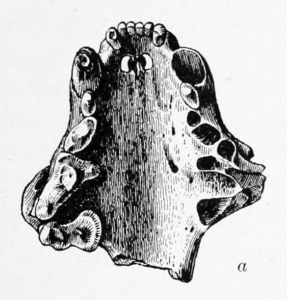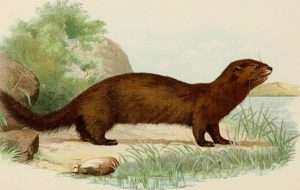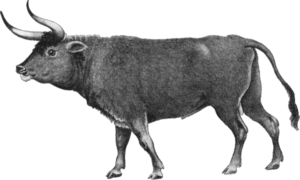
I recently learned about a mustelid that only went extinct less than 150 years ago. The sea mink (Neogale macrodon) was found on coastlines bordering the Gulf of Maine, and possibly further along the New England coast. While the only remains we have of it are skull fragments, eyewitness accounts from those who observed and even hunted it describe it as being larger than its closest relative, the still-extant American mink (Neogale vison). It also reportedly had redder-colored fur, and I wonder if it may have had somewhat longer legs given that it was often compared to a greyhound in build. (I doubt it was as tall as a greyhound, of course.)
There’s debate as to whether the sea mink was really a unique species, or merely a particularly large subspecies of the American mink. Unfortunately, given that the species went extinct due to overhunting in the late 1800s, and no complete skeletons (or even complete bones) have been found, we don’t have a good way to settle that debate right now. And that, I think, encapsulates the tragedy that is unnecessary extinction.
Never To Return
Let me continue by saying that I don’t think there has to be a “necessary” extinction. Rather, there are the extinctions that have happened over billions of years as species have competed with each other for niches, and the losers have either been bred out of existence, or simply disappeared over time. These are simply a product of how natural selection works, and how different species adapt–or fail to do so–in the face of environmental changes.
What I consider the unnecessary extinctions are those that we caused, and didn’t have to, but did anyway. Homo sapiens as a species is set apart not only by the unprecedented impact that we have had on our planet and its many ecosystems and beings, but also in our awareness of that impact. If all the lemmings that snowy owls (Bubo scandiacus) relied on for food in an area went extinct because there were too many owls and not enough lemmings, the owls would not recognize that they had over-hunted their prey. They would simply move on to new hunting grounds, as often happens with lemming boom-and-bust cycles. Other animals notice when food is scarce, or when they can’t find a mate, but we can’t say that they can conceptualize the idea of extinction.
So I think it’s important for us to also set the extinctions we have caused apart specifically because of our unique awareness of the wider context of our actions. This is not merely one species unknowingly hunting another into oblivion without understanding the numbers involved and the tipping points when the prey species reaches the point of no return. We know what we’re doing, we can monitor widespread populations, and we have the choice to act in ways to prevent their loss–yet too often we don’t.

Of course, “just stop taking these animals” may have seemed easier said than done for those involved in the extinction of the sea mink. Planning for the future is more difficult than immediate gratification, especially when your means of living relies on the continual, often increasing, exploitation of wild species, or of natural resources. Fur trappers and hunters likely couldn’t have just jumped to a different career at a moment’s notice. And while there were certainly people around back then who could recognize the larger, systemic impact we were having, there wasn’t the cultural awareness of species endangerment and extinction that has cropped up in more recent decades with the modern environmental movement.
But what’s done is done. Never a particularly widespread animal, limited to a relatively small geographic area, the sea mink was likely easily wiped off the face of the planet. And all that’s left are some bones and a pile of unanswered questions.
Just Out of Reach
It is a naturalist’s frustration to be able to see just how close we today came to getting to see recently extinct species. 150 years is barely even an eyeblink in human history, never mind evolutionary history. There are still people today who knew people who had seen, and perhaps killed, sea mink. The same thing goes for the passenger pigeon (Ectopistes migratorius). There are still people alive who may have seen a thylacine (Thylacinus cynocephalus), an ivory-billed woodpecker (Campephilus principalis), or a golden toad (Incilius periglenes). If not for greed and the misapprehension that the world belongs to us and us alone, I could be writing today about the current natural history of the Steller’s sea cow (Hydrodamalis gigas), the aurochs (Bos primigenius primigenius), or the dodo (Raphus cucullatus). And those of us today are bearing sad witness to the extinction of the vaquita (Phocoena sinus), the northern white rhinoceros (Ceratotherium simum cottoni), and an unknown number of species never identified by science that will slip away without us ever knowing.

I began this post writing about the loss of the sea mink, whose ghost doesn’t even have a clear form for us today. But really it’s just another verse in the same old song–repetitive but for the names of the beings whittled down to none by our hands. It was just learning about yet another wonderful living being that I missed getting to know by such a short period of time that got me thinking about the wider losses, and what they mean to those of us who still grasp at their memories, floating like smoke through our fingers.
So does the sea mink lay forever out of our reach, for sake of human vanity.
